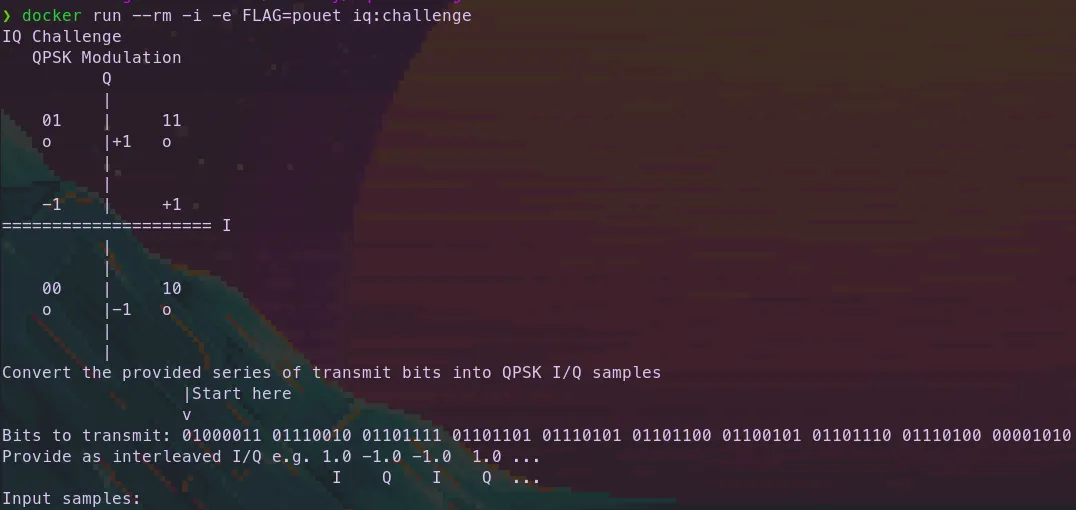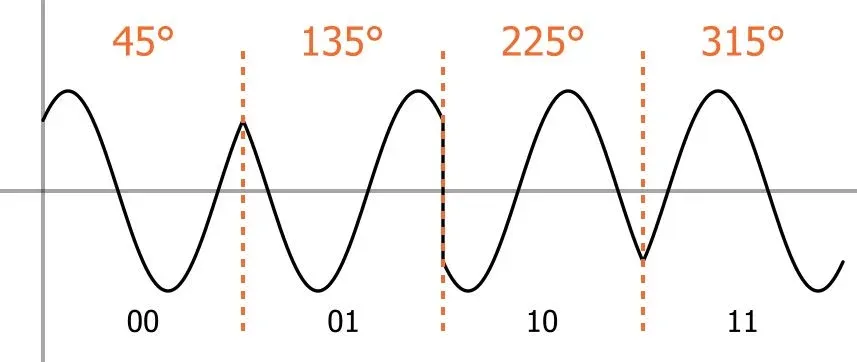Challenge description: Convert the provided series of transmit bits into in-phase quadrature (I/Q) samples.
The challenge is available at this address.
Let's connect to the challenge instance:

We are asked to convert a series of bits into an I/Q sample using QPSK (Quadrature Phase Shift Keying) modulation.
QPSK Modulation
QPSK modulation is a digital phase modulation technique where the phase of the carrier is altered to transmit data. You can review a lesson on modulation [here](just here) and on phase [here](right here).
Specifically, with this modulation, bits are grouped in pairs giving 4 possible combinations:
This can also be seen in the following diagram with alternative values, but still separated by 90°:
00, 01, 10, and 11, resulting in 4 distinct phases. Typically, each phase is separated by 90°. For example, one might assign 00 to 0°, 01 to 90°, 11 to 180°, and 10 to 270°.This can also be seen in the following diagram with alternative values, but still separated by 90°:

I/Q Sample
I (In-phase) and Q (Quadrature) are the two orthogonal components of the modulated signal. They represent the cosine and sine parts of the modulated carrier wave, respectively.
An I/Q sample represents the numerical values of these two components, allowing us to depict the phase modulation used in QPSK on a two-dimensional plane (the constellation diagram).
An I/Q sample represents the numerical values of these two components, allowing us to depict the phase modulation used in QPSK on a two-dimensional plane (the constellation diagram).
Solution
To solve the challenge, we’ll write a script in
Python. Since in QPSK the bits are encoded in pairs, we begin with the following step:bits = "01000011 01110010 01101111 01101101 01110101 01101100 01100101 01101110 01110100 00001010"
bits_pair = []
i = 0
while i < len(bits):
if bits[i] == " ": # Skip spaces (they could have been removed manually, but this keeps it neat)
i += 1
pair = bits[i:i+2]
bits_pair.append(pair)
i += 2
print(bits_pair) # ['01', '00', '00', '11', '01', '11', '00', '10', '01', '10', '11', '11', '01', '10', '11', '01', '01', '11', '01', '01', '01', '10', '11', '00', '01', '10', '01', '01', '01', '10', '11', '10', '01', '11', '01', '00', '00', '00', '10', '10']
Each bit pair is mapped to a specific point in the I/Q plane where I (In-phase) is the horizontal axis and Q (Quadrature) is the vertical axis.
Based on the provided diagram, we can deduce our bit mapping scheme:
bits_map = {
"00": "-1.0 -1.0",
"01": "-1.0 1.0",
"10": "1.0 -1.0",
"11": "1.0 1.0"
}
iq_samples = []
for pair in bits_pair:
iq_value = bits_map.get(pair)
iq_samples.append(iq_value)
print(iq_samples) # ['-1.0 1.0', '-1.0 -1.0', '-1.0 -1.0', '1.0 1.0', '-1.0 1.0', '1.0 1.0', '-1.0 -1.0', '1.0 -1.0', '-1.0 1.0', '1.0 -1.0', '1.0 1.0', '1.0 1.0', '-1.0 1.0', '1.0 -1.0', '1.0 1.0', '-1.0 1.0', '-1.0 1.0', '1.0 1.0', '-1.0 1.0', '-1.0 1.0', '-1.0 1.0', '1.0 -1.0', '1.0 1.0', '-1.0 -1.0', '-1.0 1.0', '1.0 -1.0', '-1.0 1.0', '-1.0 1.0', '-1.0 1.0', '1.0 -1.0', '1.0 1.0', '1.0 -1.0', '-1.0 1.0', '1.0 1.0', '-1.0 1.0', '-1.0 -1.0', '-1.0 -1.0', '-1.0 -1.0', '1.0 -1.0', '1.0 -1.0']
Finally, we construct our QPSK sample:
qpsk = ' '.join(iq_samples)
print(qpsk)
Just run the entire script and you'll see output like:
python .\iq.py
-1.0 1.0 -1.0 -1.0 -1.0 -1.0 1.0 1.0 -1.0 1.0 1.0 1.0 -1.0 -1.0 1.0 -1.0 -1.0 1.0 1.0 -1.0 1.0 1.0 1.0 1.0 -1.0 1.0 1.0 -1.0 1.0 1.0 -1.0 1.0 -1.0 1.0 1.0 1.0 -1.0 1.0 -1.0 1.0 -1.0 1.0 1.0 -1.0 1.0 1.0 -1.0 -1.0 -1.0 1.0 1.0 -1.0 -1.0 1.0 -1.0 1.0 -1.0 1.0 1.0 -1.0 1.0 1.0 1.0 -1.0 -1.0 1.0 1.0 1.0 -1.0 1.0 -1.0 -1.0 -1.0 -1.0 -1.0 -1.0 1.0 -1.0 1.0 -1.0
Copy and paste the output and you’ll receive the flag :)
> docker run --rm -i -e FLAG=pouet iq:challenge
[...]
Input samples: -1.0 1.0 -1.0 -1.0 -1.0 -1.0 1.0 1.0 -1.0 1.0 1.0 1.0 -1.0 -1.0 1.0 -1.0 -1.0 1.0 1.0 -1.0 1.0 1.0 1.0 1.0 -1.0 1.0 1.0 -1.0 1.0 1.0 -1.0 1.0 -1.0 1.0 1.0 1.0 -1.0 1.0 -1.0 1.0 -1.0 1.0 1.0 -1.0 1.0 1.0 -1.0 -1.0 -1.0 1.0 1.0 -1.0 -1.0 1.0 -1.0 1.0 -1.0 1.0 1.0 -1.0 1.0 1.0 1.0 -1.0 -1.0 1.0 1.0 1.0 -1.0 1.0 -1.0 -1.0 -1.0 -1.0 -1.0 -1.0 1.0 -1.0 1.0 -1.0
You got it! Here's your flag:
pouet

